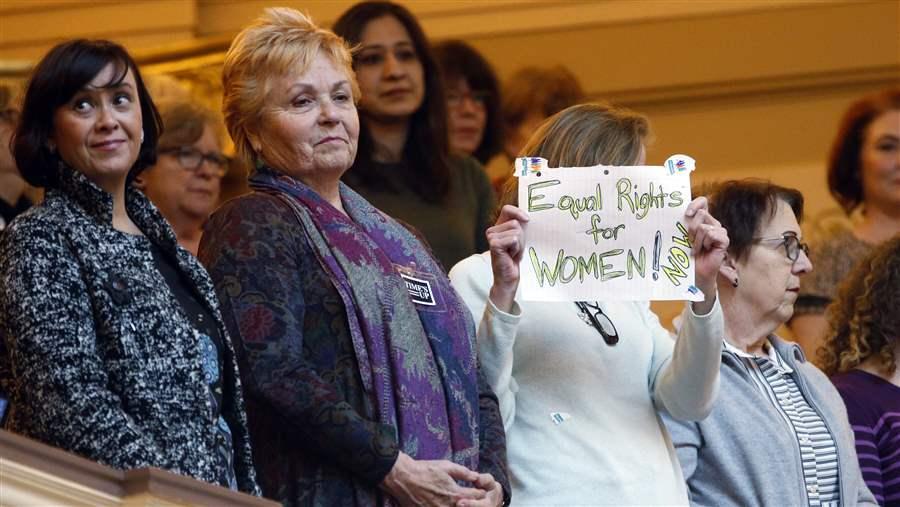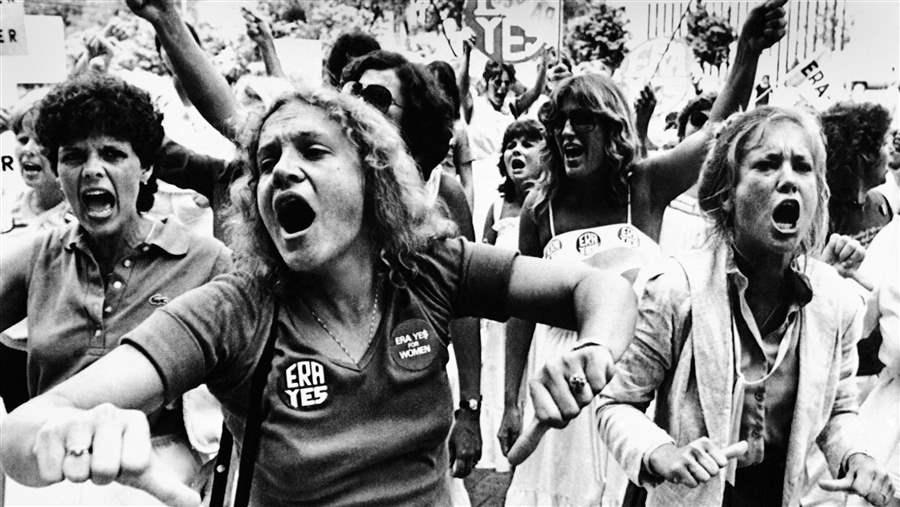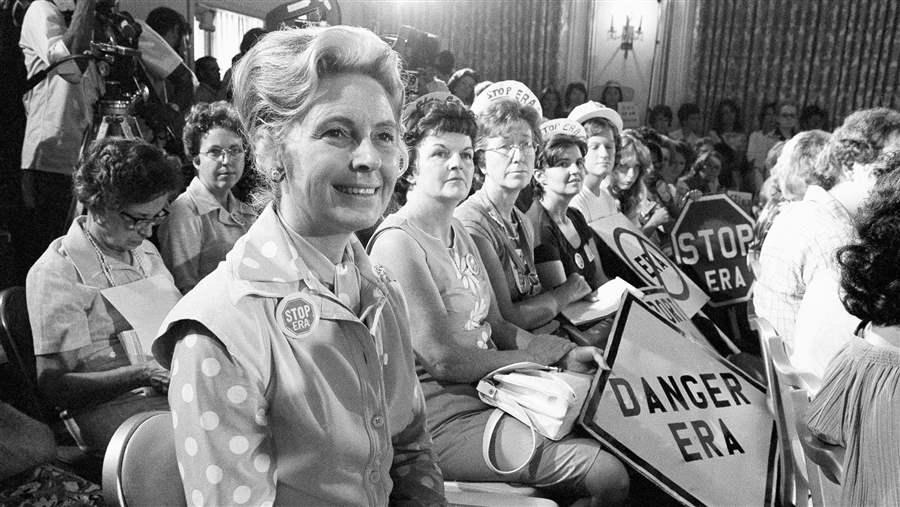
Supporters of the Equal Rights Amendment hold a sign as they are introduced in the gallery of the Virginia House earlier this month. The fight for the constitutional amendment is drawing momentum from the 2016 election and the #MeToo movement.
Steve Helber/The Associated Press
Scott Surovell was a baby in a stroller when his mother took him to hearings on the Equal Rights Amendment in the early 1970s, and growing up, he often heard stories about the need for the ERA.
Now a Democratic state senator in Virginia, the 46-year-old has introduced a bill to ratify the ERA for the last six years, three when he was a member of the Virginia House and three in the Senate. Surovell has fallen short every time — most recently Feb. 9, when House and Senate committees quashed it. The Republican committee chairmen said floor votes were improper because the time limit for ratification set by Congress expired in 1982.
This year’s loss came despite a spirited demonstration by more than a hundred supporters in the Capitol, who sang “We Shall Overcome” and shouted “Shame! Shame!”
Many Americans either think the ERA is already part of the U.S. Constitution or that it has gone the way of John Travolta’s white leisure suit in “Saturday Night Fever.” But the fight goes on, and it is drawing fresh momentum from the 2016 election and the #MeToo movement.
The Constitution says an amendment must be approved by three-fourths of the states. But it does not mention a deadline, so supporters argue that Congress can extend the 1982 ERA deadline again, or waive it. The 27th Amendment on congressional pay raises, for example, was ratified 203 years after Congress proposed it.
Nevada last March became the 36th state to approve the ERA, meaning that supporters need only two more states to reach the 38 required for ratification. Before Nevada, the last state to ratify had been Indiana in 1977.
“The votes have all been hair-breadth losses — until Nevada,” said Roberta W. Francis, ERA education consultant for the Alice Paul Institute, a nonprofit in New Jersey that advocates for women. “This is a time when there’s a lot more energy under the ERA.”
Besides Nevada and Virginia, the
states that did not ratify by the 1982 deadline are: Alabama, Arizona, Arkansas, Florida, Georgia, Illinois, Louisiana, Mississippi, Missouri, North Carolina, Oklahoma, South Carolina and Utah.

Equal Rights Amendment supporters voice their disapproval of the Florida Senate’s defeat of an ERA ratification bill in 1982.
The Associated Press
Twenty-three states have added equal rights amendments to their state constitutions, mostly during the years the national ERA effort was moribund. Oregon added an equal rights guarantee to its Constitution in 2014, and legislators in Delaware and Vermont are working on state ERAs this year.
“We’re seeing a sea change where it’s becoming much harder to deny the truths of women’s voices,” said Georgia state Sen. Nan Orrock, a Democrat who has worked to ratify the ERA during 31 years in the Legislature. “There’s a palpable sense of women on the move.”
Nevada Surprise
The federal ERA’s main provision states that “equality of rights under the law shall not be denied or abridged by the United States or any State on account of sex.”
An ERA was first introduced in Congress in 1923, and Congress approved it in 1972, sending it to the states for ratification with a deadline of 1979, and extending it in 1978, to 1982.
In the current Congress, U.S. Sen. Ben Cardin, a Maryland Democrat, and U.S. Rep. Jackie Speier, a California Democrat, have proposed removing the deadline, allowing the ERA to become part of the Constitution as soon as a 38th state ratifies it. U.S. Rep. Carolyn Maloney, a New York Democrat, would start over with new language in a “fresh start” amendment.
One question mark is how to count the five states — Nebraska, Tennessee, Idaho, Kentucky and South Dakota — that later rescinded their ratifications. Courts have not ruled whether rescission is lawful.
In Nevada, the ERA’s prospects were bleak until just recently. Democratic Nevada state Sen. Pat Spearman got nowhere when she pushed for ERA ratification in 2015.
“People would tell me it was nothing more than a stunt, it didn’t mean anything, and we shouldn’t be wasting people’s time,” she said.
But when Democrats won control of the Nevada Legislature in 2016, Spearman saw her chance. Another advantage: Female lawmakers now make up about 40 percent of the Nevada Legislature, as much as any state.
Last March, the Nevada Senate passed the measure 13-8, with all Democrats and one Republican female senator voting in favor. In the Nevada Assembly, the vote was 28-14, again with all Democrats and one Republican woman voting for passage.
“If you had called me in mid-2016, I would not have said Nevada would ratify,” said Bettina Hager, Washington, D.C., director of the ERA Coalition and Fund for Women’s Equality, an advocacy group.
“What happened was everything was lined up,” Hager said. “You need three things to be in play: a strong lead sponsor, advocates working on the ground, and the makeup of the Legislature. Nobody was expecting it to go that well.”
Illinois as Epicenter
Illinois, long the epicenter of the Stop ERA movement, is poised to be a battleground once again.
State Sen. Heather Steans, a Democrat, said a number of Republicans who support the ERA but fear a challenge from the right have told her privately they will vote for it in April, after the March 20 primary.
Pro-ERA groups have formed a coalition that is sponsoring screenings around the state of a documentary about women, “Equal Means Equal.”
Michelle Fadeley, the Illinois chapter president for the National Organization for Women, said for the last six months she has been speaking at least four times a month to
large audiences at screenings. “We are highly hopeful it’s going to happen this year in Illinois.”

Phyllis Schlafly, leader of the effort to defeat the Equal Rights Amendment, in 1976.
The Associated Press
Phyllis Schlafly, who was born in St. Louis and lived in Alton, Illinois, was the face of the national fight against the ERA during the 1970s and early ’80s. Schlafly argued that the amendment would lead to coed bathrooms, require women to be drafted into the military and taxpayers to pay for abortions, among other things.
Over the years, the kinds of changes in society Schlafly warned about have come to pass — without the ERA. Same-sex marriage and adoption by gay couples are legal, women voluntarily serve in combat, and mothers can be required to pay child support.
Schlafly died in 2016 at 92, but the Eagle Forum she founded continues the fight, using many of her arguments.
“You could compel women to be drafted and put into combat,” said Elise Bouc, chairwoman of Stop ERA Illinois. “Now they have a choice, but they’d have to be drafted in equal ratios to men and placed in equal ratios in front-line combat.”
The Catholic Conference of Illinois, which lobbies on behalf of church members in the state Capitol, also plans to oppose the ERA, said Bob Gilligan, conference executive director. The conference did not take a stand the last two legislative sessions, when it was focused on tax issues involving church schools.
“This issue has been around since 1972, and many believe the clock has expired with the time allotted to pass the ERA,” Gilligan said. “We’re also opposed because the language should more accurately reflect current issues.” He said his group is worried that courts might use the ERA to mandate publicly funded abortions, or force Catholic hospitals to perform gender reassignment surgeries.
Stuck in the ’70s?
But some legal scholars have the opposite worry: that the 1970s ERA isn’t expansive enough.
“My idea for the ERA today is we should not be stuck in the 1970s,” said Julie C. Suk, professor at Cardozo School of Law at Yeshiva University, who has studied equal rights measures around the world.
“We need to start thinking about remaining inequalities — persistent pay inequity, lack of accommodation for pregnancies, and lack of paid parental leave,” she said. “Will the ERA help us solve these problems or stand in our way?”
The current ERA language prohibits discrimination by states and the federal government but not corporations. Judges could decide what the amendment covers, Suk said, adding that for judges to understand the amendment’s intent, supporters need to be loud.
In Virginia, Surovell is planning his strategy for next year.
“I’m going to find a Republican chief sponsor,” he said, noting that the ERA has bipartisan support in the General Assembly, and two Republicans on the Senate Rules Committee voted in favor.
“All politicians — Republican and Democrat — need to be aware that women are very upset right now with what’s going on in Washington,” Surovell said. “They’re looking for an affirmative story.”



